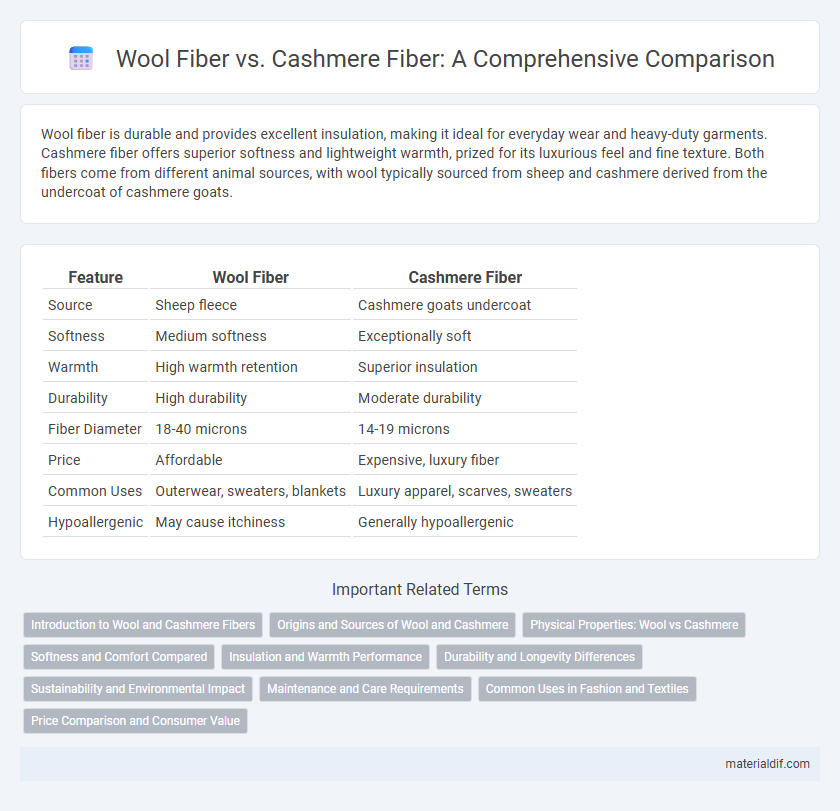Wool fiber is durable and provides excellent insulation, making it ideal for everyday wear and heavy-duty garments. Cashmere fiber offers superior softness and lightweight warmth, prized for its luxurious feel and fine texture. Both fibers come from different animal sources, with wool typically sourced from sheep and cashmere derived from the undercoat of cashmere goats.
Table of Comparison
| Feature | Wool Fiber | Cashmere Fiber |
|---|---|---|
| Source | Sheep fleece | Cashmere goats undercoat |
| Softness | Medium softness | Exceptionally soft |
| Warmth | High warmth retention | Superior insulation |
| Durability | High durability | Moderate durability |
| Fiber Diameter | 18-40 microns | 14-19 microns |
| Price | Affordable | Expensive, luxury fiber |
| Common Uses | Outerwear, sweaters, blankets | Luxury apparel, scarves, sweaters |
| Hypoallergenic | May cause itchiness | Generally hypoallergenic |
Introduction to Wool and Cashmere Fibers
Wool fiber, derived primarily from sheep, offers durability, elasticity, and excellent insulation due to its natural crimp and lanolin content. Cashmere fiber comes from the undercoat of Cashmere goats, renowned for its exceptional softness, fine micron diameter (typically 14-19 microns), and lightweight warmth. Both fibers are prized luxury textiles, with wool excelling in resilience and moisture wicking, while cashmere is valued for its unparalleled softness and thermal insulation.
Origins and Sources of Wool and Cashmere
Wool fiber primarily originates from sheep breeds such as Merino, sourced globally from regions including Australia, New Zealand, and South America, known for their fine and resilient fibers. Cashmere fiber is derived from the undercoat of Cashmere goats found mainly in Mongolia, China, and parts of Iran, prized for its exceptional softness and insulating properties. The distinct geographic and species origins significantly influence the texture, quality, and availability of wool and cashmere fibers.
Physical Properties: Wool vs Cashmere
Wool fiber is coarser and thicker, typically measuring 18-40 microns in diameter, making it more durable and insulating but less soft than cashmere. Cashmere fibers are finer, usually around 14-19 microns, offering exceptional softness, warmth, and lightweight comfort due to their fine diameter and hollow core structure. Wool's crimped texture provides elasticity and resilience, whereas cashmere's smooth, fine fibers result in a silky feel with superior thermal regulation.
Softness and Comfort Compared
Wool fiber offers moderate softness and natural warmth, making it durable and breathable for everyday wear, while cashmere fiber excels in exceptional softness, providing a luxuriously smooth and lightweight feel against the skin. Cashmere's finer diameter fibers rank around 14-19 microns compared to wool's 25-40 microns, enhancing comfort and reducing itchiness. The superior insulation and softness of cashmere fiber make it a premium choice for sensitive skin and high-end garments.
Insulation and Warmth Performance
Wool fiber provides excellent insulation due to its crimped structure that traps air, making it highly effective at retaining body heat in cold environments. Cashmere fiber, derived from the undercoat of cashmere goats, offers superior warmth with a finer and softer texture, allowing it to insulate more efficiently by minimizing heat loss through thinner fabric layers. Both fibers excel in thermal insulation, but cashmere typically delivers greater warmth-to-weight ratio, making it ideal for lightweight yet highly insulating garments.
Durability and Longevity Differences
Wool fiber is known for its superior durability, with natural crimp and elasticity that help it resist wear and maintain shape over time, making it ideal for heavy-use garments. Cashmere fiber, while softer and more luxurious, is finer and more delicate, which can lead to quicker pilling and less resistance to abrasion. The longevity of wool products typically surpasses cashmere, as wool fibers recover better from bending and stretching during daily wear.
Sustainability and Environmental Impact
Wool fiber is generally more sustainable due to its renewable nature and biodegradability, with sheep grazing often integrated into natural ecosystems that support soil health. Cashmere fiber, derived from cashmere goats, presents greater environmental challenges, including overgrazing and higher water consumption, which contribute to desertification and habitat loss. Both fibers require careful management practices, but wool's lower ecological footprint makes it a preferable option for sustainable textile production.
Maintenance and Care Requirements
Wool fiber requires regular gentle washing with mild detergent and careful drying to maintain its softness and durability, and it benefits from occasional brushing to prevent matting. Cashmere fiber demands even more delicate care, including hand washing or dry cleaning, avoiding excessive friction to prevent pilling, and careful storage to preserve its fine texture. Both fibers benefit from moisture control and protection from moths, but cashmere's higher sensitivity necessitates more meticulous maintenance to ensure longevity.
Common Uses in Fashion and Textiles
Wool fiber is widely used in fashion for its durability and warmth, making it ideal for sweaters, coats, and scarves, as well as upholstery and blankets in textiles. Cashmere fiber is prized for its softness and luxury, commonly found in high-end garments like sweaters, shawls, and suits, as well as premium knitwear. Both fibers serve distinct purposes, with wool favored for everyday wear and cashmere reserved for luxury fashion items.
Price Comparison and Consumer Value
Wool fiber generally offers a more affordable price point compared to cashmere fiber, making it a cost-effective choice for consumers seeking warmth and durability. Cashmere fiber, sourced from the undercoat of cashmere goats, commands a higher price due to its superior softness, lightweight feel, and insulating properties. While cashmere delivers luxury and enhanced comfort, wool provides excellent value for practicality and budget-conscious shoppers.
Wool Fiber vs Cashmere Fiber Infographic

 materialdif.com
materialdif.com